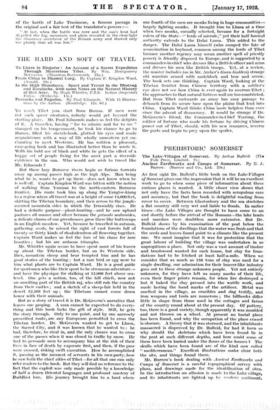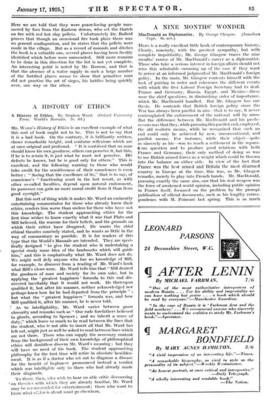PREHISTORIC SOMERSET
Ancient Earthworks and Camps of Somerset. By E. J. Burrow. (Burrow and CO, Ltd. 25s.) AT first sight Dr. Bulleid's little book on the Lake-Villages of Somerset gives one the impression that it will be an excellent work to go to when some piece of information about these
curious places is wanted. A little closer view shows that not only have the facts been recorded with scrupulous care and accuracy, but that the book is delightful reading from cover to cover. Between Glastonbury and the sea stretches a flat country still very wet and liable to floods. In earlier times—the Lake Villages are thought to have come to an end shortly before the arrival of the Romans—the lake lands and marshes were doubtless more extensive. But Dr.
Bulleid shows by his examination of the peat below the foundations of the dwellings that the water was fresh and that the seeds and leaves found point to a climate like the present one. We must imagine that it was for protection that the great labour of building the village was undertaken in so unpropitious a place. Not only was a vast amount of timber and brushwood wanted for each house, but clay for foun- dations had to be fetched at least half-a-mile. When we consider that as much as 150 tons of clay was used for a single dwelling, our admiration for their beaver-like industry goes out to these strange unknown people. Yet not entirely unknown, for they have left us many marks of their life, even their finger prints remain, for when fire destroyed a but it baked the clay pressed into the wattle work, and made lasting the hand marks of the artificer. Metal was smelted in the village, as crucibles and slag testify, and iron weapons and tools are numerous ; the billhooks differ little in shape from those used in the cottages and farms of the country round about at the present day. Of pottery, too, there is a good variety, though apparently it was moulded and not thrown on a wheel. At present no burial place has been found, and why the occupation of the place ceased is obscure. A theory that it was stormed, and the inhabitants massacred is disproved by Dr. Bulleid, for had it been so why should the skeletons which have been found lie in the peat at such different depths, and how could some of them have been buried under the floors of the houses ? The skulls which have been found are of the kind now called " mediterranean." Excellent illustrations make clear both the site, and things found there.
Mr. Burrow's book dealing with Ancient Earthworks and Camps of Somerset is a careful topographical survey with plans, and drawings, made for the identification of sites.
In the introduction an allusion is made to the Lake village, and its inhabitants arc lighted up by modern sentiment.
Here we are told that they were peace-loving people mas- sacred by foes from the Eastern downs, who set the thatch on fire with red hot clay pellets. Unfortunately Dr. Bulleid proves that though an occasional fire took place there was no general conflagration, and he states that the pellets were made in the village. But as a record of mounds and ditches the book is a valuable one, several places having been freshly identified which before were unrecorded. Still more remains to be done in this direction for the list is not yet complete. An interesting point is noted by Mr. Burrow, and that is that the absence of a water supply in such a large number of the fortified places seems to show that primitive man did not practise the art of sieges, his battles being quickly over, one way or the other.











































 Previous page
Previous page